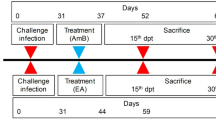Abstract
The liver fluke Fasciola hepatica infects a wide range of hosts, and has a considerable impact on the agriculture industry, mainly through infections of sheep and cattle. Further, human infection is now considered of public health importance and is hyperendemic in some regions. The fluke infection causes considerable damage to the hosts’ liver. However, the mechanisms of liver destruction have not yet been completely elucidated. In the present report we incubated a human liver cell line in the presence of either F. hepatica excretory/secretory material (FhES) or recombinant phosphoglycerate kinase (FhPGK). Dosedependent cytotoxicity in the presence of FhES was observed, indicating that FhES is capable of killing human hepatocytes, supporting a role for FhES in damaging host liver cells during infection; while treatment with a recombinant intracellular protein — FhPGK, had no impact on cell survival.
Similar content being viewed by others
References
Behm C.A., Sangster N.C. 1999. Pathology, pathophysiology and clinical aspects. In: (Ed. J.P. Dalton) Fasciolosis. CABI Publishing, Wallingford, 185–224.
Berasain P., Goni F., McGonigle S., Dowd A., Dalton J.P., Frangione B., Carmona C. 1997. Proteinases secreted by Fasciola hepatica degrade extracellular matrix and basement membrane components. Journal of Parasitology, 83, 1–5.
Donnelly S., O’Neill S.M., Sekiya M., Mulcahy G., Dalton J.P. 2005. Thioredoxin peroxidase secreted by Fasciola hepatica induces the alternative activation of macrophages. Infection and Immunity, 73, 166–173. DOI: 10.1128/IAI.73.1.166-173.2005.
Flynn R.J., Irwin J.A., Olivier M., Sekiya M., Dalton J.P., Mulcahy G. 2007. Alternative activation of ruminant macrophages by Fasciola hepatica. Veterinary Immunology and Immunopathology, 120, 31–40. DOI: 10.1016/j.vetimm.2007.07.003.
Gajewska A., Smaga-Kozlowska K., Kotomski G. 2006. Effect of excretory-secretory products of Fasciola hepatica on the functioning of rat hepatocytes. Medycyna Weterynaryjna, 62, 459–462.
Guasconi L., Serradell M.C., Masih D.T. 2012. Fasciola hepatica products induce apoptosis of peritoneal macrophages. Veterinary Immunology and Immunopathology, 148, 359–363. DOI:10.1016/j.vetimm.2012.06.022.
Hamilton C.M., Dowling D.J., Loscher C.E., Morphew R.M., Brophy P.M., O’Neill S.M. 2009. The Fasciola hepatica tegumental antigen suppresses dendritic cell maturation and function. Infection and Immunity, 77, 2488–2498. DOI: 10.1128/IAI.00919-08.
Jaros S., Jaros D., Wesolowska A., Zygner W., Wedrychowicz H. 2010. Blocking Fasciola hepatica’s energy metabolism — a pilot study of vaccine potential of a novel gene — phosphoglycerate kinase. Veterinary Parasitology, 172, 229–237. DOI: 10.1016/j.vetpar.2010.05.008.
Jefferies J.R., Campbell A.M., van Rossum A.J., Barrett J., Brophy P.M. 2001. Proteomic analysis of Fasciola hepatica excretory-secretory products. Proteomics, 1, 1128–1132. DOI: 10.1002/1615-9861(200109)1:9〈1128::AID-PROT1128〉3.0.CO;2-0.
Mas-Coma S. 2005. Epidemiology of fascioliasis in human endemic areas. Journal of Helminthology, 79, 207–216. DOI: 10.1079/JOH2005296.
Morphew R.M., Wright H.A., LaCourse E.J., Woods D.J., Brophy P.M. 2007. Comparative proteomics of excretory-secretory proteins released by the liver fluke Fasciola hepatica in sheep host bile and during in vitro culture ex host. Molecular & Cellular Proteomics: MCP, 6, 963–972. DOI: 10.1074/mcp.M600375-MCP200.
Norbury L.J., Beckham S., Pike R.N., Grams R., Spithill T.W., Fecondo J.V., Smooker P.M. 2011. Adult and juvenile Fasciola cathepsin L proteases: different enzymes for different roles. Biochimie, 93, 604–611. DOI: 10.1016/j.biochi.2010.12.004.
Robinson M.W., Menon R., Donnelly S.M., Dalton J.P., Ranganathan S. 2009. An integrated transcriptomics and proteomics analysis of the secretome of the helminth pathogen Fasciola hepatica: proteins associated with invasion and infection of the mammalian host. Molecular & Cellular Proteomics: MCP, 8, 1891–1907. DOI: 10.1074/mcp.M900045-MCP200.
Serradell M.C., Guasconi L., Masih D.T. 2009. Involvement of a mitochondrial pathway and key role of hydrogen peroxide during eosinophil apoptosis induced by excretory-secretory products from Fasciola hepatica. Molecular and Biochemical Parasitology, 163, 95–106. DOI: 10.1016/j.molbiopara.2008.10.005.
Wesołowska A., Gajewska A., Smaga-Kozłowska K., Kotomski G., Wędrychowicz H. 2012. Effect of Fasciola hepatica proteins on the functioning of rat hepatocytes. Parasitology Research, 110, 395–402. DOI: 10.1007/s00436-011-2504-3.
WHO. 1995. Control of foodborne trematode infections: report of a WHO study group. World Health Organization technical report series, 849, 1–157.
Wilson R.A., Wright J.M., de Castro-Borges W., Parker-Manuel S.J., Dowle A.A., Ashton P.D., Young N.D., Gasser R.B., Spithill T.W. 2011. Exploring the Fasciola hepatica tegument proteome. International Journal for Parasitology, 41, 1347–1359. DOI: DOI 10.1016/j.ijpara.2011.08.003.
Author information
Authors and Affiliations
Corresponding author
Rights and permissions
About this article
Cite this article
Bąska, P., Norbury, L.J., Wiśniewski, M. et al. Excretory/secretory products of Fasciola hepatica but not recombinant phosphoglycerate kinase induce death of human hepatocyte cells. Acta Parasit. 58, 215–217 (2013). https://doi.org/10.2478/s11686-013-0126-x
Accepted:
Published:
Issue Date:
DOI: https://doi.org/10.2478/s11686-013-0126-x




